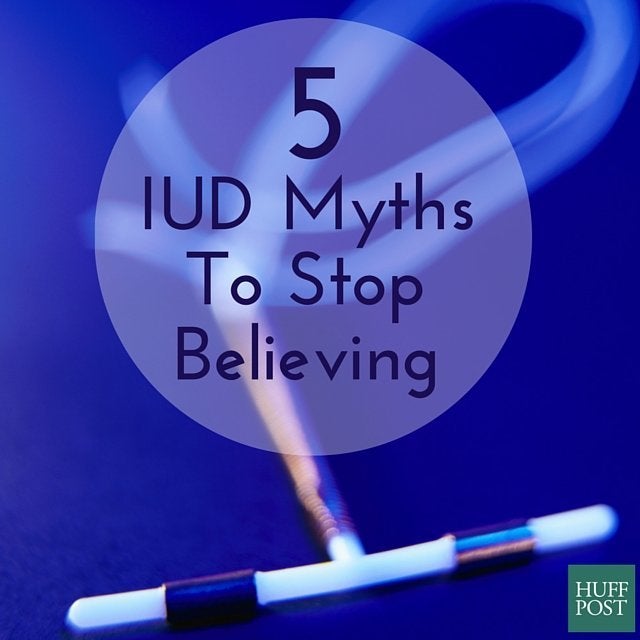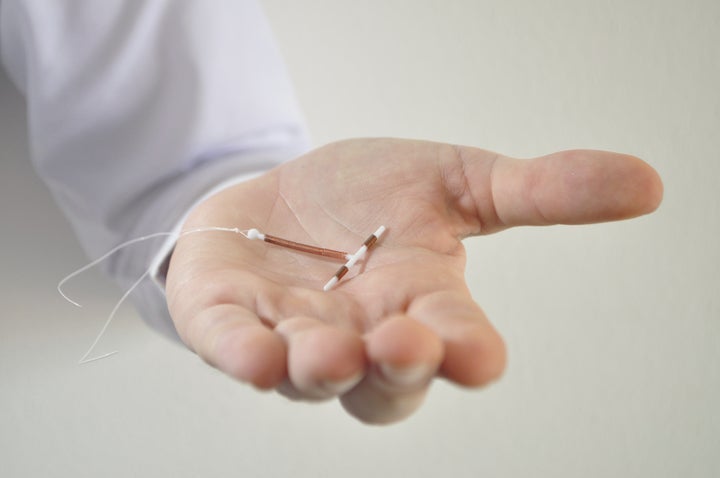
Intrauterine devices are one of most effective methods of birth control on the market, especially when you account for human error, such as condoms breaking during sex or occasionally forgetting to take a birth control pill.
Based on typical use, IUDs are 45 times more effective that the pill and 90 times more effective than male condoms, according to the Guttmacher Institute.
The small, T-shaped devices -- we're talking half the size of a tube of Chapstick -- are also long-lasting and easily reversible. After a doctor inserts the IUD into a woman's uterus, the device can prevent pregnancy for between three and 10 years, depending the model she chooses. There are currently four models on the market, including three that release low levels of hormones over time. The hormone-free version has copper coiled around its frame, creating a reaction in the body that makes the uterus toxic to sperm, thereby preventing fertilization.
Using the IUD can mean a faster return to fertility after it's removed, which is helpful for women who foresee wanting to get pregnant in the near future. "The pill suppresses ovulation more than the IUD," said Amy Bryant, an assistant professor of obstetrics and gynecology at the University of North Carolina. "Some women will return immediately to fertility, but others won’t. And with the IUD, it seems that it’s just a little bit quicker."
If IUDs are so great, why don't more women have them?
While IUDs are the contraceptive method of choice for female women's health providers -- 40 percent of whom choose the birth control method for themselves -- only 12 percent of contraception-using women in the general population chose the IUD.
This is in part because getting any IUD used to be more expensive, with total costs adding up to as much as $1,000 for women who either didn't have insurance or whose insurance didn't cover birth control. Now, with passage of the Affordable Care Act and a new low-cost device called Liletta, which runs about $50 at health care clinics, IUDs are more financially feasible.
Although the risks are low, the IUD does come with a few side effects. One out of 1,000 IUD insertions results in a uterine perforation, a risk that's slightly higher if the woman has just given birth and is still lactating, though it is still rare. Women who choose the non-hormonal ParaGard IUD can experience heavier periods and more intense menstrual cramps, symptoms they might not be accustomed to if they're switching from hormonal birth control. In contrast, women who opt for the hormonal Mirena IUD may find that their period goes away completely.
There's also a lot of mythology surrounding IUDs. Some women are under the impression that the device is only for approved for those who have already had children. Others have heard horror stories about IUD insertion and how painful it is.
Birth control isn't one-size-fit-all -- different women prefer different types of contraception -- but being well-informed about your options, and recognizing which myths are well, myths, will help you make the best selection for you.
Here are five myths about IUDs we can put to rest for good:

Myth 1: It's risky to get an IUD before you've had kids.
In fact, it's just opposite. The American Academy of Pediatrics and the American Congress of Obstetricians and Gynecologists both recommend IUDs as the first line of defense for adolescents who are sexually active, primarily because they are safe and incredibly effective.
"Anybody who is sexually mature, anybody who has gone through puberty, is able to use an IUD," Bryant said.
Myth 2: Having an IUD put in will be the most painful experience of your life.
Every woman has a different pain tolerance, which explains why one of your girlfriends says getting an IUD was "Really effing painful," and another swears it was "No big deal."
While getting an IUD put in is certainly unpleasant, for most women the paint is short-lived. "It feels like a couple of really big menstrual cramps," Bryant said. "For some women, they experience those really, really severely, and for other women it’s really pretty mild."
In any case, Bryant recommends having a discussion with your doctor about your pain tolerance before you get an IUD. "The vast majority of women get them placed without any problem at all," she said. "I like to say it’s five minutes of discomfort for five years of excellent birth control."
Myth 3: Your IUD could fall out.
Your body could expel the IUD from your uterus, but it's fairly unlikely. (It happens about 3 to 5 percent of the time, according to Bryant, and is most likely to occur within three months of having the device inserted.) If the device is expelled, you're at risk for unintended pregnancy, which is why doctors recommend that women use a backup contraception method for the first few weeks after getting the device.
"People just need to be aware of that -- in case it does fall out," Bryant said. "Sometimes they’ll feel a big cramp or they’ll have a big clot, and the IUD will come out with it."
If you're worried that your IUD is longer in place, your doctor can show you how to check the device's strings (a thin nylon thread that sticks out of the cervix into the vagina, making the IUD easy to remove). You can also have your health care provider check the device for you.
Myth 4: IUDs cause infection and infertility.
This rumor has some history behind it. "Back in the '70s and the '60s, there was a really bad IUD on the market," Bryant explained. "It caused infertility. It caused women to lose their uteruses and some women lost their lives."
The Dalkon Shield was taken off the market, but its nightmarish legacy continues to haunt modern-day IUDs.
And doctors are part of the problem. Although 40 years of data show that modern-day IUDs are safe, and don't carry a higher risk of infection, some doctors are passing misinformation on to their patients. A 2012 survey published in the journal Obstetrics & Gynecology found that 30 percent of obstetricians, gynecologist, family doctors, nurses and physicians assistants thought that IUDs were unsafe for women who had never given birth.
"The IUDs we have today are safe and they don’t cause infertility," Bryant said. "They don’t cause infection. Infection causes infection, but the IUD itself won’t make it worse or better."
Myth 5: Doctors have to induce a contraction to put the IUD in your uterus.
Although the term "contraction" is associated with labor, a contraction and a cramp are essentially the same thing -- a squeezing movement of the uterus and likely a sensation that you've felt before before. "People get contractions or cramping from periods, because their cervix is opening up a little bit to let the blood out," Bryant explained.
When putting in an IUD, a doctor will open up your cervix slightly, first to measure your uterus, and then to insert the device. Both of those motions stretch the cervix. "It can cause a pretty big cramp," Bryant said. "It’s not like giving a medicine or anything to cause a contraction."
Also on HuffPost: